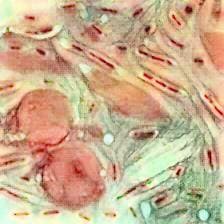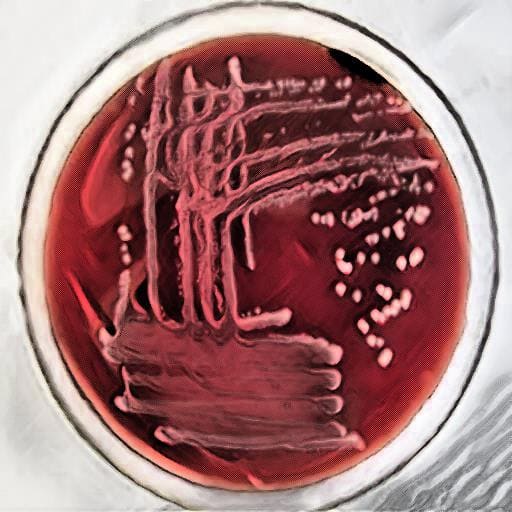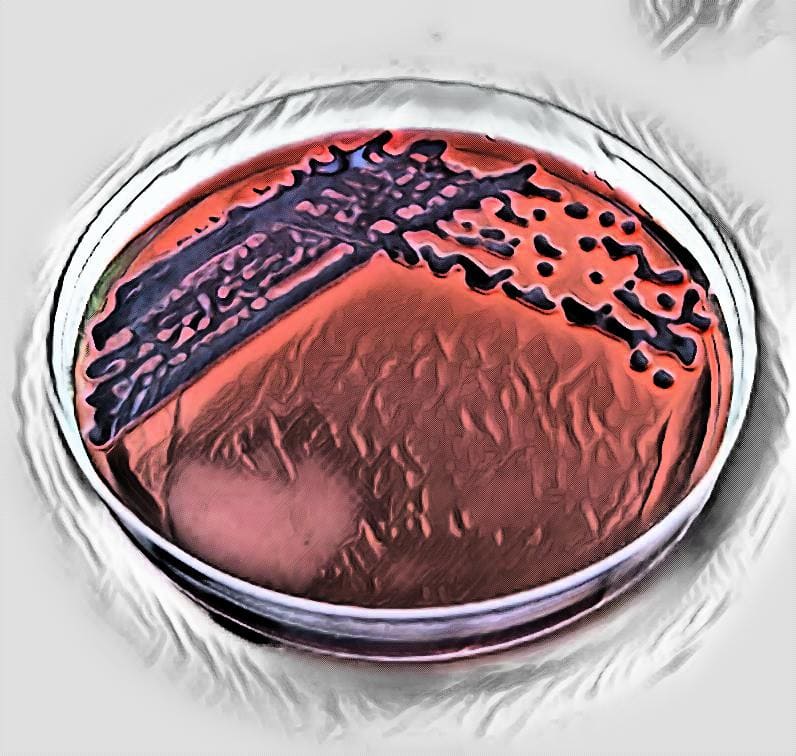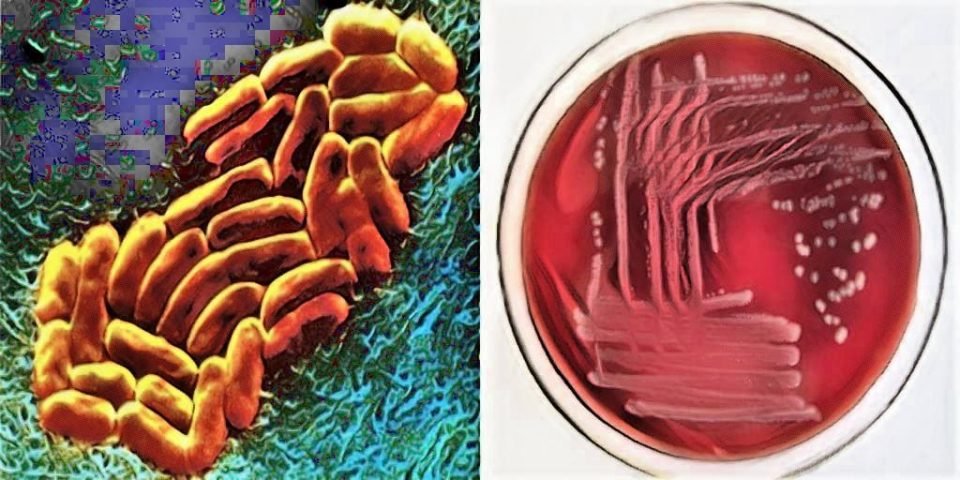Hey, Good to see you here 😀 …… In this Article, We’re gonna discuss in Detail the Morphology & Culture characteristics of Klebsiella pneumoniae….. If you have any queries, don’t forget to mention in Comments….. Thanks
Morphology of Klebsiella pneumoniae
Klebsiella pneumoniae is a short, plump, straight rod shape (bacillus) bacterium.
The size of Klebsiella pneumoniae is about 1–2 µm × 0.5–0.8 µm (micrometer).
K. pneumoniae is arranged singly, in pairs, or in short chains and sometimes in clusters.

Klebsiella pneumoniae is a non-motile bacterium.
K. pneumoniae is a non-flagellated bacterium.
The Klebsiella pneumoniae is a non–sporing bacterium.
Capsules are present in Klebsiella pneumoniae which can easily be demonstrated using India ink preparation, appear as a clear halo in a dark background.
Klebsiella pneumoniae is a Gram -ve (Negative) bacterium.
Culture Requirements of Klebsiella pneumoniae (K. pneumoniae)
Special requirements – Klebsiella pneumoniae have no complex nutritional requirements and readily grow in an ordinary media like Nutrient Agar medium (NAM). Commonly the NAM & MacConkey Agar medium is used for the cultivation of Klebsiella pneumoniae in Laboratory.
Optimum temperature – Klebsiella pneumoniae ranges from 15–40°C but the optimum temperature for most of the strains is 37°C and usually cultivated at this temperature in laboratories.
Optimum pH – K. pneumoniae can survive alkaline pH but not at acidic pH and the maximum growth of the organism is observed at 7.0 i.e. neutral pH. Also, the pH requirement varies as per the strain of Klebsiella pneumoniae.
Oxygen requirements – Klebsiella pneumoniae (K. pneumoniae) is an aerobic bacterium i.e. grow best in the presence of oxygen and it is also a Facultative anaerobic organism i.e. can grow in the low oxygen environment.
⇒ There are various culture media used for the cultivation of Klebsiella pneumoniae in the laboratory and most commonly the Nutrient Agar medium and MacConkey Agar medium is used, the other media are as follows –
- Columbia Horse Blood Agar medium
- Sheep Blood Agar medium
- Trypticase Soy Agar medium
- Eosin Methylene Blue Agar (EMB Agar) Medium.
- The liquid medium (Nutrient Broth medium, TSB medium, etc.).
⇒ The Eosin Methylene Blue Agar (EMB Agar) medium which is the Selective medium for Klebsiella pneumoniae contains Eosin dye and Methylene Blue dye which inhibits the growth of many gram-positive bacteria, inhibits the growth of Shigella and Salmonella species and supports the growth of Klebsiella pneumoniae.
Culture Characteristics of Klebsiella pneumoniae (K. pneumoniae)
Cultural Characteristics Nutrient Agar Medium (NAM) MacConkey Agar medium Blood Agar Medium EMB Agar medium
Shape Circular Circular Circular Circular
Size 2-3 mm 2-3 mm 2-3 mm 2-3 mm
Elevation Dome-shaped Convex Dome-shaped Convex
Surface Mucoid Mucoid Mucoid Mucoid
Color Greyish white Pink – Red Greyish white Pink – Purple
Structure Translucent–Opaque Opaque Translucent–Opaque Translucent–Opaque
Hemolysis ----- ----- γ-Hemolysis (Non-hemolytic) -----
In Liquid culture media like Trypticase soy broth or Nutrient broth, the growth of the bacterium occurs as a turbidity in the broth medium which is further analyzed for the morphology (under the microscope), gram reaction, biochemical tests, and Klebsiella pneumoniae specific tests.
In Blood Agar medium, the Klebsiella pneumoniae colonies are non-hemolytic i.e. shows Gamma Hemolysis (γ-hemolysis).

In MacConkey Agar medium, the colonies of Klebsiella pneumoniae are pink colored due to the lactose fermentation which is of great importance in differentiating K. pneumoniae from other Bacteria present in the specimen, especially from Gram-positive bacteria and Salmonella species which are non–lactose fermentors and gives colorless colonies on MacConkey agar medium.

In Eosin Methylene Blue Agar (EMB) medium, the colonies of Klebsiella pneumoniae are Pink to purple in color without green metallic sheen which is of great importance in differentiating K. pneumoniae from other bacteria normally found in Specimen and especially from E. coli which grows with Green metallic sheen.

That’s all about the Morphology and Culture Characteristics of Klebsiella pneumoniae….
Frequently Asked Questions (FAQs)
Q1. What are the colony characteristics of Klebsiella pneumoniae on nutrient agar?
On nutrient agar, Klebsiella pneumoniae colonies appear large, smooth, and mucoid with a pale yellow coloration. They may also exhibit a stringy consistency.
Q2. How do you identify Klebsiella on a culture plate?
To identify Klebsiella on a culture plate, a Gram stain can be performed. Klebsiella will appear as Gram-negative rods. Additional tests such as biochemical tests, API systems, or molecular methods can also be employed for accurate identification.
Q3. What is the morphology of Klebsiella pneumoniae on blood agar?
On blood agar, Klebsiella pneumoniae colonies appear round, smooth, and convex with a mucoid consistency. They have a pale white or light gray coloration.
Q4. What are the physiological characteristics of Klebsiella?
Klebsiella pneumoniae is a facultative anaerobic bacterium that can ferment glucose, lactose, and other sugars. It is also able to produce large amounts of capsule polysaccharides, which contribute to its virulence.
Q5. What are the cultural characteristics of K pneumonia?
Cultural characteristics of Klebsiella pneumoniae include a preference for nutrient-rich media and the ability to grow at a wide range of temperatures. It also has a tendency to produce a mucoid or stringy consistency in its colonies.
Q6. What culture media is used for Klebsiella pneumonia?
Klebsiella pneumoniae can be grown on a variety of culture media, including nutrient agar, blood agar, MacConkey agar, and eosin methylene blue agar.
User Review
( votes)
Laboratory Hub aims to provide the Medical Laboratory Protocols & General Medical Information in the most easy to understand language so that the Laboratory Technologist can learn and perform various laboratory tests with ease. If you want any protocol to be published on Laboratory Hub, Please drop a mail at contact@laboratoryhub.com. Happy Learning!

